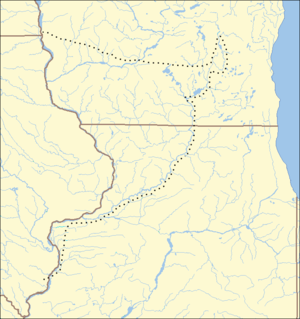Spafford Farm massacre
| Spafford Farm Massacre | |||||||
|---|---|---|---|---|---|---|---|
| Part of the Black Hawk War | |||||||
 Monument near South Wayne, Wisconsin. | |||||||
| |||||||
| Belligerents | |||||||
|
|
Black Hawk's British Band | ||||||
| Strength | |||||||
| 6 | unknown | ||||||
| Casualties and losses | |||||||
| 4 killed | 1 killed | ||||||
The Spafford Farm massacre, also referred to as the Wayne massacre, was an attack upon U.S. militia and civilians that occurred as part of the Black Hawk War near present-day South Wayne, Wisconsin. Spafford Farm was settled in 1830 by Omri Spafford and his partner Francis Spencer.
Before the war started they made numerous improvements to the parcel of land. On June 14, 1832 five men were attacked by a Kickapoo war party, three whites were killed instantly, including Spafford. In total at least one Native and four white settlers were killed in the action. Two men managed to escape. One mistakenly feared for days that Fort Hamilton had been captured, before finally seeking refuge there. The incident at Spafford Farm eventually led to the Battle of Horseshoe Bend (also known as the Battle of Pecatonica).
Background
As a consequence of an 1804 treaty between the
Prelude
| Map of Black Hawk War sites Symbols are wikilinked to article |
The Spafford Farm massacre, also known as the Wayne massacre, occurred in
Massacre
On June 14, 1832 the six men were sent from Fort Hamilton to work on Spafford Farm.[7] The group had just commenced working when they were attacked by a band of Kickapoo warriors.[4][6] The warriors had concealed themselves in some trees near the farmstead and opened fire in a surprise attack.[6] The men dropped their tools and broke for the Pecatonica River, reaching the river and making a hasty crossing. Having crossed the river, four of the men were shot as they clambered up the opposite bank.[6]
Spafford, Searles and McIllwaine were killed instantly in the melee; also killed was "Bull" (probably John Compton).[4][7] Spencer and 17-year-old Million were able to escape the attackers. Million escaped by jumping into the Pecatonica River, hiding in brush and making his way to Fort Hamilton.[4] Spencer's escape was a longer process.[4] He did not jump into the river, but hid along the banks. One of the attackers pursued him but Spencer killed the warrior before he could be overtaken.[4] He wandered the woods for several days before reaching Fort Hamilton.[4]
Spencer reached Fort Hamilton around the same time that Colonel William S. Hamilton[8] arrived with a large group of Menominee who had volunteered against the Sauk and Fox.[4][9] Afraid that the fort had also been attacked, Spencer retreated back into the woods. He avoided the fort for between six and nine days, when hunger finally drove him into the open where he realized his mistake.[6][9]
Aftermath

Word of the attack at Spafford's farm spread quickly to
Colonel
After the massacre, General
See also
- List of massacres in Wisconsin
Notes
42°34′30″N 89°55′44″W / 42.57500°N 89.92889°W
- ^ a b Lewis, James. "Phase Three The Black Hawk War of 1832". Lincoln / Net. Retrieved May 26, 2018.
- ^ "May 14: Black Hawk's Victory at the Battle of Stillman's Run", Historic Diaries: The Black Hawk War, Wisconsin State Historical Society. Retrieved August 6, 2007.
- ^ "May 21, Indian Creek, Ill.: Abduction of the Hall Sisters", Historic Diaries: The Black Hawk War, Wisconsin State Historical Society. Retrieved September 27, 2007.
- ^ a b c d e f g h i j History of LaFayette County, Wisconsin, (Google Books), Consul Willshire Butterfield, Western Historical Co: 1881, p. 599. Retrieved August 1, 2007.
- ^ Natl Archives, Black Hawk War Index Card, Iowa County, Wisconsin Militia, W.S. Hamilton's Company
- ^ ISBN 0805077588).
- ^ a b c d e Braun, Robert A. "A Chronology," Black Hawk's War April 5 - August 2, 1832, September 2001, Old Lead Historical Society. Retrieved August 6, 2007.
- ^ Son of Alexander Hamilton. See Wakefield, footnote 54.
- ^ a b ; Reprinted as: Wakefield's History of the Black Hawk War, Original Publication: Jacksonville, Ill.: Calvin Goudy, 1834. Reprint Publication: Chicago: The Caxton Club, 1908, Chapter 4, Section 70. Retrieved August 1, 2007.
- LeClaire, Antoine, interpreter; Patterson, J. B., ed., Autobiography of Ma-Ka-Tai-Me-She-Kia-Kiak, or Black Hawk, Embracing the Traditions of his Nation, Various Wars In Which He Has Been Engaged, and His Account of the Cause and General History of the Black Hawk War of 1832, His Surrender, and Travels Through the United States. Also Life, Death and Burial of the Old Chief, Together with a History of the Black Hawk War, Oquawka, IL: J. B. Patterson, 1882, "History of the Black Hawk War", Section 169. Retrieved August 1, 2007.

